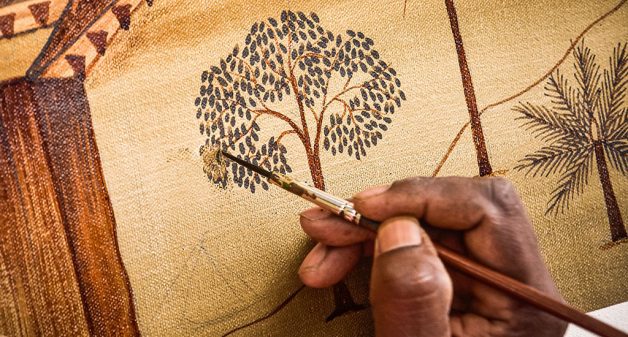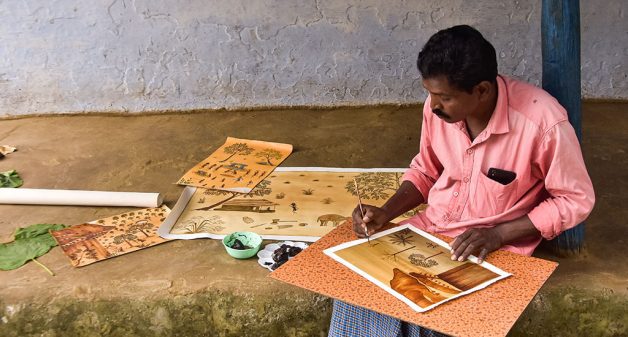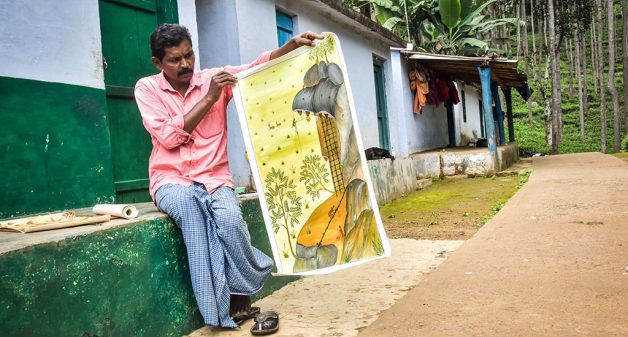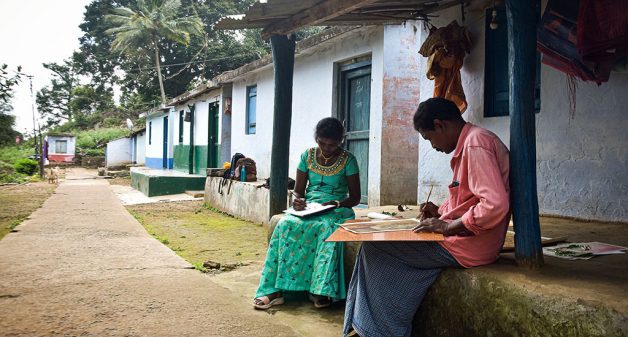
Keeping Kurumba art alive
Ala Kurumba tribes inherited a flair for art from their forefathers who captured everyday life as rock paintings. But with only a handful of such artists left, they are desperate to keep this cultural expression alive.

Ala Kurumba tribes inherited a flair for art from their forefathers who captured everyday life as rock paintings. But with only a handful of such artists left, they are desperate to keep this cultural expression alive.
Until a few years ago there were no proper roads to get to Baviyur, a remote village of Tamil Nadu where the story of a tribal community has been passed down as rock paintings.
Even today there are very few buses that reach this tribal hamlet about 30 kilometres from Kotagiri in Nilgiris district. The undulating roads today pass through verdant tea plantations to take one to Baviyur, where Ala Kurumbas, a tribal community, dwell. They also live in another village Vellaraikombu, home to ancient rock paintings.
The painting culture of the Ala Kurumba tribes began when their ancestors made rock paintings almost 4,000 years ago.
The art portrays the life of these tribal communities and has been passed down through generations.
Each painting carries a complete story – a remembrance of the culture of Ala Kurumbas.
Yet, today only five Kurumba artists practice this art.
P Balasubramanian has been painting for 24 years, like his father and grandfather before him. This art is his sole livelihood. While his ancestors painted on rocks, he paints on paper and canvas.
He and the other four artists have to travel to Coonoor, about 50 kilometres away, to buy papers and canvas.
“Earlier, paintings were done on mud houses also, during festival times,” said Balasubramanian.
Balasubramanian and another Kurumba artist, Krishnan, have been teaching the children in their village in hopes of keeping the art alive.

“Through these paintings, we want them to understand and know our culture,” he said.
Art as a reflection of life
“There are many stories in these paintings. Like the community collecting forest produce like gooseberry or honey,” Balasubramanian told Village Square.
Some of the pieces have riddles in them. Others have the stories of traditions and habits.
The story of honey collection is one such well documented tradition.
“Before we go out to extract honey, we go into the forest where the deity is, and pray, so that no harm befalls us,” Balasubramanian said.
The tribal beekeepers would collect a certain kind of wood, burn it as an incense offering to the deity and then enter the forest.
Balasubramanian’s daughter, Kalpana, has heard many such stories from her father.
“The honey hunters don’t tell anyone at home before they leave. They offer prayers before smoking the beehive, so that the bees don’t sting them. They sing the same song, when they finish and are about to return. The oldest member in the community walks as the last person, as a protector. After they collect honey, they do not look back,” she recalled.

All these aspects of their life are painted exquisitely in their art. Even the minute nuances of the wildlife, like a tree cavity with a bird inside, deer, hornbills can be seen as a form of detailing in these paintings. Every tree they paint is a tree that they know and associate with because of their customs.
Balasubramanian believes that these paintings of their stories should continue to be done by the Kurumbas as this is ingrained in them and this was the life their ancestors lived.
Colours from nature
In fact, even the colour pigment for their art comes from trees in their forest.
The community worships their guardian deity before venturing into the forest to collect material for the colours. In their paintings one can see the community praying to the deity.
In summer, when Vengai tree oozes out a liquid, the artists place coconut shells underneath the tree to collect the liquid. From this one tree they get three colours: yellow, brown and black.
The dark and light green colours are derived from leaves of other plants. These leaves are crushed and made into a paste without using water.
Making art sustainable
“When some people see the figures from our Kurumba art, they compare it with Warli art. But this is not Warli art,” said Balasubramanian emphatically. “Our art tells stories of our tribal community. Sometimes people copy these paintings. But by drawing one or two figures it cannot become Kurumba art.”
“The state government offers support to those who create Warli paintings, which is most likely why Warli art is popular,” he said. “If such measures are taken for us here in Tamil Nadu, it would benefit us.”
Arvind Sundar, a well-regarded Coimbatore-based contemporary artist, believes the first step for conserving ancient art is to build awareness.
“Warli paintings are in the school curriculum, it’s popular and even a layman might know it,” Sundar said.
He suggests more publicity, like a low-cost documentary showcasing Kurumba art, as a good starting point to get more people interested in this particular tribal art.
“The artists can talk about their art on public forums and hold exhibitions of their paintings too,” he added.

With a keen interest in their ancestral art, Kalpana and her brother Bharath have learnt the art from their father.
Through workshops they try to get children and teenagers from their community interested in the art.
Kalpana has worked tirelessly to spread the love of her tribe’s art. She regularly paints pictures about the stories of her ancestors. She envisions their past and paints their stories.
“There are small differences in the way I paint certain elements and my father paints them. Like the shape of the broom or house,” she said.
Like her father, she also firmly believes that this knowledge should be imparted to the youth of their tribal community since they would be able to relate to their ancestors and their lives.
All five of the remaining Kurumba artists hope the government will step up and support their art.
“For the art to reach the next generation of Kurumbas, our stories – down to the colour shading – must be documented. If the government gives us a small space, we could train more young people,” said Balasubramanian.
Sharada Balasubramanian is a Coimbatore-based developmental journalist and no relation to the subjects in this story.